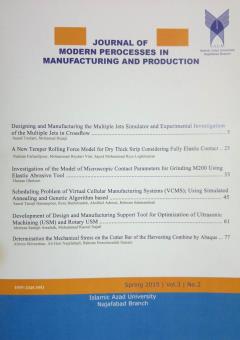The Effect of Manufacturing Method and Material Type on the Solar Battery Charging Rate
Subject Areas :
1 -
Keywords: Solar Battery, Charge Estimation, Mechanical Characteristics, Depth of Discharge (DoD), State of Charge (SoC),
Abstract :
Photovoltaic (PV) batteries exhibit distinct mechanical properties that render them well-suited for integration into solar energy systems. These properties include the ability to withstand mechanical stresses, such as bending or pressure, during the handling, installation, and operational phases of use. High durability is essential to ensure consistent performance across diverse environmental conditions over their extended service life. This study presents empirical data derived from laboratory testing of solar cells, with a focus on comparing the battery charge percentage displayed by a 12/24V charge controller against theoretically estimated values. The calculations are based on the voltage difference (ΔV) between the open-circuit voltage (Voc) and the minimum standard battery voltage. The analyzed results were normalized into percentages, resulting in the development of an equation that demonstrates strong alignment with experimental observations. A comparative assessment of various battery technologies is presented, along with an investigation into the mechanical properties of solar cells. The findings indicate that advanced materials, including perovskite and monocrystalline silicon, when combined with optimized manufacturing techniques such as roll-to-roll processing and laser scribing, significantly improve charging efficiency.
[1] Brunner, C., Deac, G., Braun, S. and Zophel, C. 2020. The future need for flexibility and the impact of fluctuating renewable power generation. Renewable Energy. 149: 1314–1324. doi: 10.1016/j.renene.2019.10.128.
[2] Glavin, M. and Hurley, W. G. 2006. Battery management system for solar energy applications. Proceedings of the 41st International Universities Power Engineering Conference (UPEC). Newcastle upon Tyne, UK. 1: 79–83. doi: 10.1109/UPEC.2006.367719.
[3] Prabhakar, B. M., Ramprabhakar, J. and Sailaja, V. 2016. Estimation and controlling the state of charge in battery augmented photovoltaic system. Biennial International Conference on Power and Energy Systems: Towards Sustainable Energy (PESTSE). 1–6. doi: 10.1109/PESTSE.2016.7516431.
[4] Tangwiwat, B. and Audomvongseree, K. 2018. Benefit and cost analysis of the installation of rooftop solar PV with battery system. 15th International Conference on Electrical Engineering/Electronics, Computer, Telecommunications and Information Technology (ECTI-CON). 505–508. doi: 10.1109/ECTICon.2018.8619990.
[5] Kharseh, M., Balah, M. and Alamara, K. 2024. Estimating state of charge of battery in renewable energy systems: a data-driven approach with artificial neural networks. Clean Energy. 8(6): 134–147. doi: 10.1093/ce/zkae084.
[6] Vazquez, S., Lukic, S. M., Galvan, E., Franquelo, L. G. and Carrasco, J. M. 2010. Energy storage systems for transport and grid applications. IEEE Transactions on Industrial Electronics. 57(12): 3881–3895. doi: 10.1109/TIE.2010.2076414.
[7] Narayan, N., Papakosta, T., Vega-Garita, V., Qin, Z., Popovic-Gerber, J., Bauer, P. and Zeman, M. 2018. Estimating battery lifetimes in solar home system design using a practical modelling methodology. Applied Energy. 228: 1629–1639. doi: 10.1016/j.apenergy.2018.06.152.
[8] Narayan, N., Papakosta, T., Vega-Garita, V., Popovic-Gerber, J., Bauer, P. and Zeman, M. 2017. A simple methodology for estimating battery lifetimes in solar home system design. IEEE AFRICON. Cape Town. 1195–1201. doi: 10.1109/AFRCON.2017.8095652.
[9] Hlal, M. I., Ramachandaramurthy, V. K., Sarhan, A., Pouryekta, A. and Subramaniam, U. 2019. Optimum battery depth of discharge for off-grid solar PV/battery system. *Journal of Energy Storage. 26: 100999. doi: 10.1016/j.est.2019.100999.
[10] Asif, A. and Singh, R. 2017. Further cost reduction of battery manufacturing. Batteries. 3(2): 17. doi: 10.3390/batteries3020017.
[11] Ma, C., Zhang, L., Wang, Y., Xu, D., Li, X. and Zhou, Y. 2025. A review of parameter identification and state of power estimation methods for lithium-ion batteries. Processes. 12(10): 2166. doi: 10.3390/pr12102166.
[12] Ngoy, K. R., Chen, H., Wang, J., Yang, S. and Zhou, L. 2025. Lithium-ion batteries and the future of sustainable energy: a comprehensive review. Renewable and Sustainable Energy Reviews. 223: 115971. doi: 10.1016/j.rser.2025.115971.
[13] Njema, G. G., Mwangi, P., Otieno, A. and Muriithi, J. 2024. A review on the recent advances in battery development and energy storage technologies. Journal of Renewable Energy. 2024(1): 2329261. doi: 10.1155/2024/2329261.
[14] Vega-Garita, V., Narayan, N., Qin, Z., Popovic-Gerber, J., Bauer, P. and Zeman, M. 2019. Selecting a suitable battery technology for the photovoltaic battery integrated module. Journal of Power Sources. 438: 227011. doi: 10.1016/j.jpowsour.2019.227011.
[15] Mauler, L., Duffner, F. and Leker, J. 2021. Economies of scale in battery cell manufacturing: The impact of material and process innovations. Applied Energy. 286: 116499. doi: 10.1016/j.apenergy.2021.116499.
[16] Alsharif, K. I., Pesch, A. H., Borra, V., Li, F. X., Cortes, P., Macdonald, E. and Choo, K. 2022. A coupled thermo-mechanical dynamic characterization of cylindrical batteries. IEEE Access. 10: 51708–51722. doi: 10.1109/ACCESS.2022.3173640.
[17] Polman, A., Atwater, H. A., Catchpole, K. R., Garnett, E. C., Kitamura, K. and Walukiewicz, W. 2016. Photovoltaic materials: Present efficiencies and future challenges. Science. 352(6283): aad4424. doi: 10.1126/science.aad4424.
[18] Hu, X., Xu, H., Ding, C., Tian, Y. and Yang, K. 2025. Numerical study on the thermal behavior of lithium-ion batteries based on an electrochemical-thermal coupling model. Batteries. 11(7): 280. doi: 10.3390/batteries11070280.
[19] Nguyen, D. T., Diogo, K. and Ahmadi, F. 2022. Integration and digitalization of a TIR measurement system for roll manufacturing industry. IEEE International Workshop on Metrology for Industry 4.0 & IoT (MetroInd4.0&IoT). 392–396. doi: 10.1109/MetroInd4.0IoT54413.2022.9831771.
[20] Jiang, D., Wang, H., Liu, X., Chen, Z., Sun, Y. and Singh, R. 2024. Non-laser and all-vapor-phase processed perovskite solar modules stabilized by naturally formed barrier layers. Joule. 8(4): 1161–1175. doi: 10.1016/j.joule.2024.02.007.


